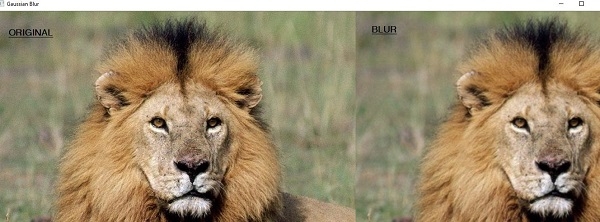
 Data Structure
Data Structure Networking
Networking RDBMS
RDBMS Operating System
Operating System Java
Java MS Excel
MS Excel iOS
iOS HTML
HTML CSS
CSS Android
Android Python
Python C Programming
C Programming C++
C++ C#
C# MongoDB
MongoDB MySQL
MySQL Javascript
Javascript PHP
PHP
- Selected Reading
- UPSC IAS Exams Notes
- Developer's Best Practices
- Questions and Answers
- Effective Resume Writing
- HR Interview Questions
- Computer Glossary
- Who is Who
OpenCV Python Program to blur an image?
OpenCV is one of the best python package for image processing. Also like signals carry noise attached to it, images too contain different types of noise mainly from the source itself (Camera sensor). Python OpenCV package provides ways for image smoothing also called blurring. This is what we are going to do in this section. One of the common technique is using Gaussian filter (Gf) for image blurring. With this, any sharp edges in images are smoothed while minimizing too much blurring.
Syntax
cv.GaussianBlur(src, ksize, sigmaX[, dst[, sigmaY[, borderType=BORDER_DEFAULT]]] )
Where−
src – input image
dst – output image
ksize – Gaussian kernel size[ height width]. If ksize is set to [0 0], then ksize is computed from sigma values.
sigmaX – Kernel standard deviation along X-axis(horizontal direction).
sigmaY – kernel standard deviation along Y-axis(Vertical direction).
Bordertype – Specifies iage boundaries while kernel is applied on image borders. Few possible values are: cv.BORDER_CONSTANT, cv.BORDER_REPLICATE, cv.BORDER_REFLECT, cv.BORDER_WRAP, cv.BORDER_DEFAULT, cv.BORDER_ISOLATED, cv.BORDER_TRANSPARENT etc.
Below is the program to Gaussian blur an image using OpenCV package.
import cv2
import numpy
# read image
src = cv2.imread('LionKing.jpeg', cv2.IMREAD_UNCHANGED)
# apply guassian blur on src image
dst = cv2.GaussianBlur(src,(3,3),cv2.BORDER_DEFAULT)
# display input and output image
cv2.imshow("Gaussian Blur",numpy.hstack((src, dst)))
cv2.waitKey(0) # waits until a key is pressed
cv2.destroyAllWindows() # destroys the window showing image
Result

The two images looks almost similar (original/blur). Now let us increase the kernel size and observe the result.
dst = cv2.GaussianBlur(src,(13,13),cv2.BORDER_DEFAULT)

Now there is a clear distinction between the two images.

